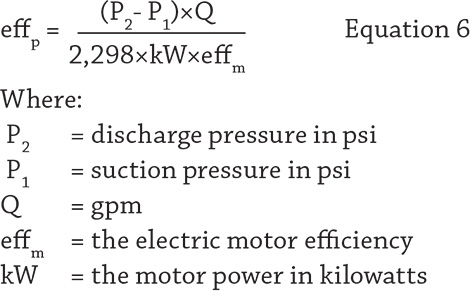A common concern in processing plants is determining the pumping health—or efficiency—of centrifugal pumps. As pump impeller seals wear as a result of erosion and corrosion mechanisms, tight internal clearances open up and allow fluid to recirculate internally, gradually degrading performance. As wear progresses, a centrifugal pump will eventually become unable to perform its intended function. Periodically monitoring pump performance allows end users to identify internal degradation before a serious loss of capability occurs.
The Old Method
In the past, plant machinery professionals have used the tried-and-true centrifugal pump horsepower equation (see Equation 1).

This equation may look simple enough, but, on closer inspection, it poses some difficulties. First, the user must determine the head. To determine the head a pump generates, the user must know the suction and discharge pressures and the specific gravity of the fluid being pumped at the actual operating conditions. Specific gravity of a liquid, however, is not always easy to determine, and it can vary with temperature and composition. Second, the user must discern the actual pump shaft horsepower. Horsepower is also difficult to measure directly. Torque-measuring couplings are available, but they sometimes can add another level of complexity to the analysis.
A Simplified Alternative
To sidestep these issues, a different equation can be used to determine centrifugal pump efficiency without having to know the liquid’s specific gravity and pump’s output shaft horsepower. This equation allows you to determine a centrifugal pump’s efficiency by only knowing these values: the pump’s discharge pressure (P2) and suction pressure (P1), flow rate (Q), electric motor efficiency (effm), and motor power in kilowatts (kW ).
First, start with the basic hydraulic brake horsepower equation to eliminate the need to know the liquid’s specific gravity (see Equation 2)

This relationship means that the motor output power is equal to the kilowatt input to the motor times the motor efficiency.



Because the brake horsepower result in Equation 2 and the motor power result in Equation 3 are expressed in different units of power, we must insert a constant into one of the relationships before we can set them equal to each other. Equation 4 shows the hydraulic power equation in terms of kilowatts.
Now, set the pump power equation (now in kW units) equal to the motor power equation to get the relationship indicated in Equation 5.

Solving for the pump efficiency term, you arrive at the final pump efficiency equation (see Equation 6).
P2 and P1 are measured with pressure gauges at the discharge and suction of the pump being assessed, Q is the total pump flow measured with a fixed or portable flow meter, and kW is the true power going to the electric motor driver.
For example, field data of a single-stage centrifugal pump driven by an electric motor might reveal the following:
P2 = 300 psi
P1 = 100 psi
Q = 600 gpm
Experience indicates that the electric motor has a mechanical efficiency of 96 percent. An electrical power meter measures that 100 kW of true power is being consumed by the electric motor under steady-state conditions.

Using the new efficiency equation, you arrive at the centrifugal pump efficiency (see Equation 7).


